Simulation of the Hydrogen Railway Engine Performance Under Different Load Conditions and Control Parameters
Abstract
1. Introduction
2. Materials and Methods
- 1.
- Air flow rate through the engine, kg/hwhere —fuel consumption, kg/h, —excess air ratio.
- 2.
- Cycle fuel supply, kg/cyclewhere n is the engine crankshaft speed, min−1.
- 3.
- Working body content in the cylinder, mol
- 4.
- Current cylinder volume by crankshaft angle of rotation per cycle, m3where .
- 5.
- Current cylinder volume increment by crankshaft rotation angle per cycle, m3/deg
- 6.
- Average indicator pressure, Pa
- 7.
- Current temperature in the cylinder by crankshaft angle of rotation in the cycle, K
- 8.
- Current heat capacity of the working body in the cylinder by crankshaft angle of rotation in the cycle, kJ/kgK
- 9.
- Current heat transfer coefficient in the cycle kW/m2K
- 10.
- Area of the internal heat-absorbing surface of the cylinder, m2
- 11.
- Relative rate of heat removal in the cycle,
- 12.
- Relative rate of effective heat releasewhere —increment of pressure in the cylinder, Pa/deg, —increment of current heat capacity of working body in the cylinder by crankshaft rotation angle in the cycle, kJ/(kmol K deg).
- 13.
- Relative combustion rate of fuel
- 14.
- Relative integral law of fuel burn-up
3. Results and Discussion
3.1. Measurement Results and Their Processing
3.2. Results of Mathematical Modeling of Hydrogen-Fueled Engine
- Peak cylinder pressure (p_max): an increase of 3–6%, most pronounced at higher crankshaft speeds, consistent with faster global heat-release on hydrogen. This has implications for mechanical loading (head clamping, bearing loads) and should be reflected in fatigue and margin assessments.
- In-cylinder and exhaust temperatures: cycle-averaged gas temperatures rise by ≈5–8% in-cylinder and ≈12–20% at the turbine/exhaust, affecting combustion-chamber thermal fluxes, turbocharger turbine-inlet margins, and exhaust system material selection/insulation.
- Mass fuel flow: the hydrogen mass flow required to hold the same brake output is substantially lower than for diesel, primarily due to hydrogen’s higher lower heating value (LHV).
3.3. Analysis of the Dependence of Hydrogen Fuel Consumption on the Operating Mode
- Forecast the cost of operating a hydrogen locomotive based on a market cost of hydrogen of $1.5–3/kg and a diesel cost of $1.5–2.1/kg. The average operating cost of fuel for the locomotive when using diesel fuel will be 35 × 1.5–2.1) = 53–74 dollars per hour, and for hydrogen, 11.5 × (1.5–3) = 17–34 dollars per hour. Thus, the economy will be 35–40 dollars per hour.
- Estimate the amount of its required stock on board the crew. To maintain the locomotive’s autonomous cruising range, it is necessary to maintain a hydrogen reserve on board as fuel (taking into account the thermal equivalent): 11.5/35 × 120,000/42,000 × 100% = 94% of the mass of diesel fuel initially contained on board. Accordingly, knowing the estimated hydrogen reserve on board and solving the inverse problem, it is possible to predict or design the locomotive’s autonomous cruising range.
- Conclude that the energy resource is saved because the ratio of 35/11.5 = 3.04 is greater than the thermal equivalent in calorific value of diesel and hydrogen, which is 2.82.
4. Conclusions
- Peak combustion pressure. Switching to hydrogen increases in maximum in-cylinder pressure by ≈3–6%, most notably at high-power settings. This rise is modest and, based on typical design margins for the engine family, is not expected to materially increase in structural loading; nonetheless, it should be verified against head clamping, bearing loads, and fatigue life.
- Gas temperatures. Cycle-averaged in-cylinder and exhaust temperatures show slight increases of ≈5–8% and ≈12–20%. These deltas can be accommodated in combustion-chamber and exhaust-system design (materials, cooling, insulation, and turbocharger turbine-inlet limits), with modifications if required.
- Fuel mass consumption and energy use. The hydrogen mass flow required at matched effective power is significantly lower than for diesel, consistent with hydrogen’s higher LHV. Even after accounting for the thermal equivalent, the integral operational mass consumption implies an ≈8% energy-resource saving, attributable primarily to improved operating processes at idle and low-load regimes (controller positions 0–3).
- Conversion feasibility. The technical and operational characteristics of the EMD 12-645E3C suggest good potential for conversion to hydrogen, provided targeted modifications are implemented to the fuel, control, and safety subsystems. Priority actions include:
- -
- Fuel-system replacement. Adopt a hydrogen injection system capable of tight, high-pressure delivery to the cylinder (e.g., direct gaseous injection), with precise timing and metering.
- -
- Combustion-chamber adaptation. Optimize chamber geometry and compression ratio to promote uniform hydrogen distribution at low excess-air ratios while mitigating knock/detonation risk.
- -
- Ignition-system design. Employ a high-energy, potentially multi-point ignition strategy to ensure robust flame initiation under lean or stratified conditions and to reduce detonation propensity.
- -
- Safety systems. Integrate enhanced leak detection, ventilation, and automatic hydrogen shut-off to prevent accumulation and possible ignition outside the cylinders; ensure fault diagnostics and interlocks across the fuel path.
Author Contributions
Funding
Data Availability Statement
Conflicts of Interest
References
- Destatis. Road Transport: EU-Wide Carbon Dioxide Emissions Have Increased by 21% Since 1990. 2024. Available online: https://www.destatis.de/Europa/EN/Topic/Environment-energy/CarbonDioxideRoadTransport.html (accessed on 21 July 2025).
- Kowalski, P.; Kołodziejczak, K.; Frąckowiak, E. Hydrogen as an alternative energy source in railway vehicles. Rail Veh. Pojazdy Szyn. 2024, 3–4, 13–17. [Google Scholar] [CrossRef]
- Smigins, R.; Amatnieks, K.; Birkavs, A.; Kryshtopa, S. Performance and emissions of an agricultural diesel engine with hydrogen injection under different load modes. Agron. Res. 2025, 23, 195–207. [Google Scholar] [CrossRef]
- Staffell, I.; Scamman, D.; Velazquez Abad, A.; Balcombe, P.; Dodds, P.E.; Ekins, P.; Shah, N.; Ward, K.R. The role of hydrogen and fuel cells in the global energy system. Energy Environ. Sci. 2019, 12, 463–491. [Google Scholar] [CrossRef]
- Zhang, Y.; Tian, Z.; Jiang, K.; Hillmansen, S.; Roberts, C. Local and global sensitivity analysis for railway upgrading between hydrogen fuel cell and electrification. High-Speed Railw. 2024, 2, 219–229. [Google Scholar] [CrossRef]
- Sun, Y.; Anwar, M.; Hassan, N.M.S.; Spiryagin, M.; Cole, C. A review of hydrogen technologies and engineering solutions for railway vehicle design and operations. Rail. Eng. Sci. 2021, 29, 212–232. [Google Scholar] [CrossRef]
- Marjani, S.R.; Motaman, S.; Varasteh, H.; Yang, Z.; Clementson, J. Assessing hydrogen as an alternative fuel for rail transport—A case study. Sci. Rep. 2025, 15, 6449. [Google Scholar] [CrossRef] [PubMed]
- D’Acierno, L.; De Matteis, L.; Stefanelli, R. Adoption of Hydrogen in Railway Traction: Opportunities and Limits in the Case of Non-Electrified Railway Lines. Transp. Res. Procedia 2025, 90, 130–137. [Google Scholar] [CrossRef]
- Wright, M.L.; Lewis, A.C. Decarbonisation of heavy-duty diesel engines using hydrogen fuel: A review of the potential impact on NOx emissions. Environ. Sci. Atmos. 2022, 2, 852–866. [Google Scholar] [CrossRef]
- Atteridge, W.J.; Lloyd, S.A. Thoughts on use of hydrogen to power railway trains. Proc. Inst. Mech. Eng. Part A J. Power Energy 2021, 235, 306–316. [Google Scholar] [CrossRef]
- Kryshtopa, S.; Górski, K.; Longwic, R.; Smigins, R.; Kryshtopa, L.; Matijošius, J. Using Hydrogen Reactors to Improve the Diesel Engine Performance. Energies 2022, 15, 3024. [Google Scholar] [CrossRef]
- Goyal, H.; Jones, P.; Bajwa, A.; Parsons, D.; Akehurst, S.; Davy, M.H.; Leach, F.C.; Esposito, S. Design trends and challenges in hydrogen direct injection (H2DI) internal combustion engines—A review. Int. J. Hydrogen Energy 2024, 86, 1179–1194. [Google Scholar] [CrossRef]
- Regele, C.; Gackstatter, F.; Ortner, F.; Preuster, P.; Geißelbrecht, M. Simulation and optimization of a liquid organic hydrogen carrier based hydrogen train system. Energy Convers. Manag. 2025, 344, 120234. [Google Scholar] [CrossRef]
- D’Ovidio, G.; Ometto, A.; Valentini, O. A novel predictive power flow control strategy for hydrogen city rail train. Int. J. Hydrogen Energy 2020, 45, 4922–4931. [Google Scholar] [CrossRef]
- Pielecha, I.; Engelmann, D.; Czerwinski, J.; Merkisz, J. Use of hydrogen fuel in drive systems of rail vehicles. Rail Veh. Pojazdy Szyn. 2022, 1–2, 10–19. [Google Scholar] [CrossRef]
- Skabelund, B.B.; Jenkins, C.D.; Stechel, E.B.; Milcarek, R.J. Thermodynamic and emission analysis of a hydrogen/methane fueled gas turbine. Energy Convers. Manag. 2023, 19, 100394. [Google Scholar] [CrossRef]
- Molkov, V. Advances in hydrogen storage technologies. J. Loss Prev. Process Ind. 2025, 94, 105561. [Google Scholar] [CrossRef]
- Onorati, A.; Payri, R.; Vaglieco, B.M.; Agarwal, A.K.; Bae, C.; Bruneaux, G.; Canakci, M.; Gavaises, M.; Günthner, M.; Hasse, C.; et al. The role of hydrogen for future internal combustion engines. Int. J. Engine Res. 2022, 23, 529–540. [Google Scholar] [CrossRef]
- Szwaja, S.; Piotrowski, A.; Szwaja, M.; Musial, D. Thermodynamic Analysis of the Combustion Process in Hydrogen-Fueled Engines with EGR. Energies 2024, 17, 2833. [Google Scholar] [CrossRef]
- Sun, B.; Zhao, H.; Dong, X.; Teng, C.; Zhang, A.; Kong, S.; Zhou, J.; Zhang, X.-C.; Tu, S.-T. Current challenges in the utilization of hydrogen energy-a focused review on the issue of hydrogen-induced damage and embrittlement. Adv. Appl. Energy 2024, 14, 100168. [Google Scholar] [CrossRef]
- Nqodi, A.; Mosetlhe, T.C.; Yusuff, A.A. Advances in Hydrogen-Powered Trains: A Brief Report. Energies 2023, 16, 6715. [Google Scholar] [CrossRef]
- Stobnicki, P.; Gallas, D. Adoption of modern hydrogen technologies in rail transport. J. Ecol. Eng. 2022, 23, 84–91. [Google Scholar] [CrossRef]
- CSX Unveils Its First Hydrogen-Powered Locomotive in Collaboration with CPKC. Hydrogen Central. Available online: https://hydrogen-central.com/csx-unveils-its-first-hydrogen-powered-locomotive-in-collaboration-with-cpkc/ (accessed on 17 April 2024).
- Agency PTI. ‘India Made Hydrogen Fuel Train Engine More Powerful Than Others’: Ashwini Vaishnaw. Available online: https://www.news18.com/india/india-made-hydrogen-fuel-train-engine-more-powerful-than-others-ashwini-vaishnaw-9184255.html (accessed on 10 January 2025).
- Wang, Y.; Zhu, G.; Shen, Z.; Chen, L.; Kou, C.; Yang, D.; Chen, W.; Zuo, Q. Numerical study of active pre-combustion chamber structure on combustion performance and emission characteristics of jet ignition pure ammonia engine. Fuel 2026, 405, 136854. [Google Scholar] [CrossRef]
- Szwaja, S.; Naber, J.D. Performance characteristics of a hydrogen fuelled S.I. engine using timed manifold injection. Int. J. Hydrogen Energy 2013, 38, 12489–12496. [Google Scholar] [CrossRef]
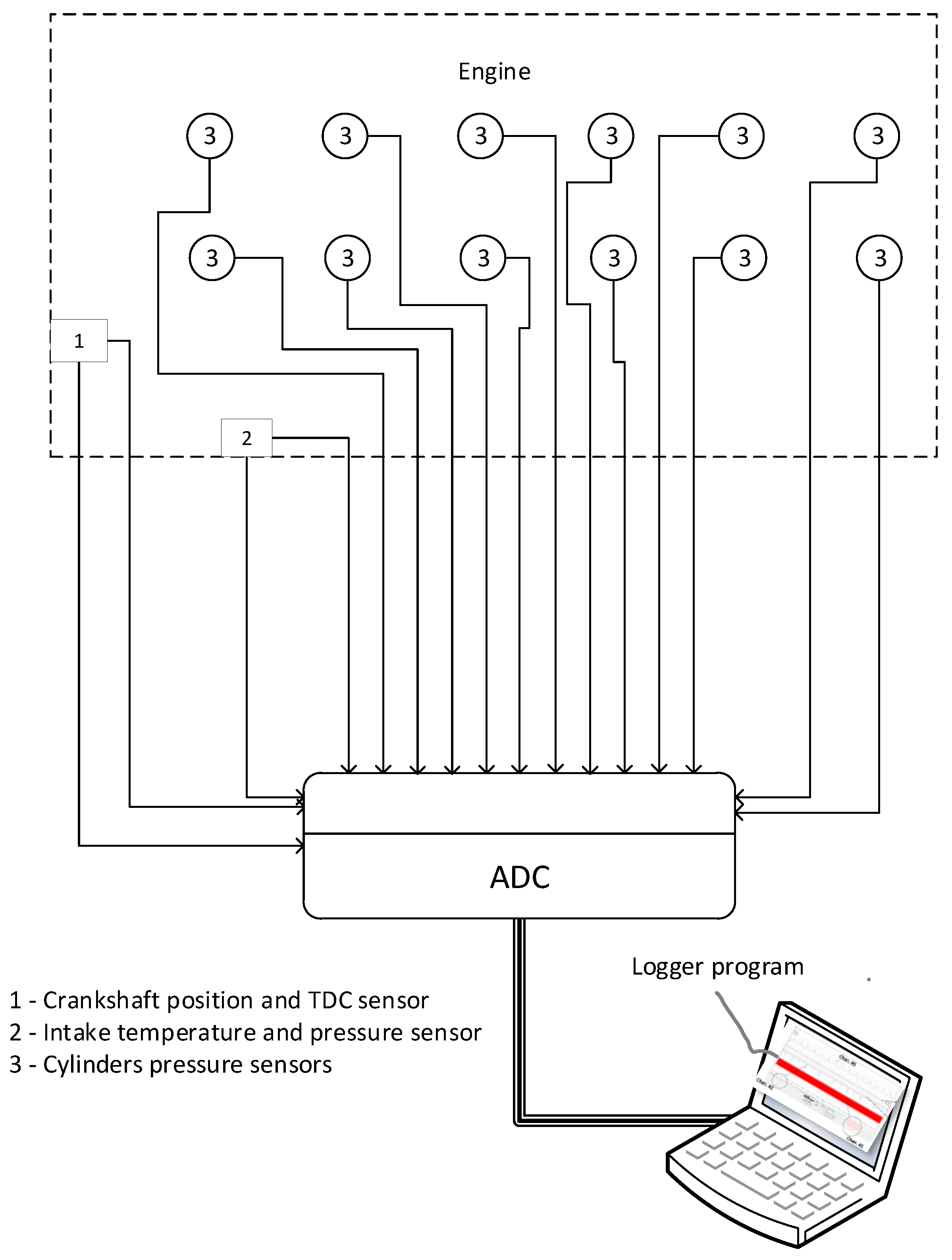
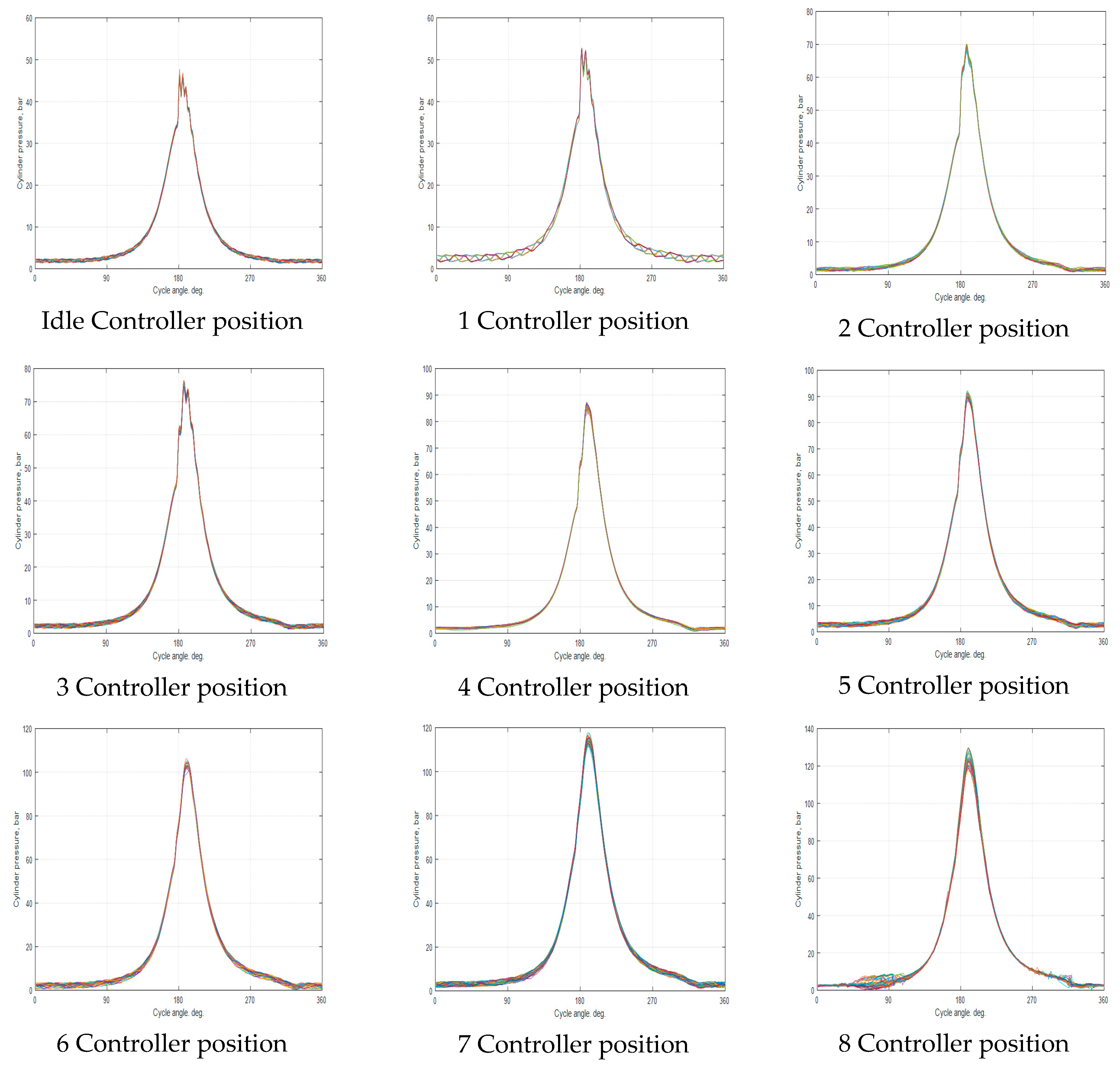
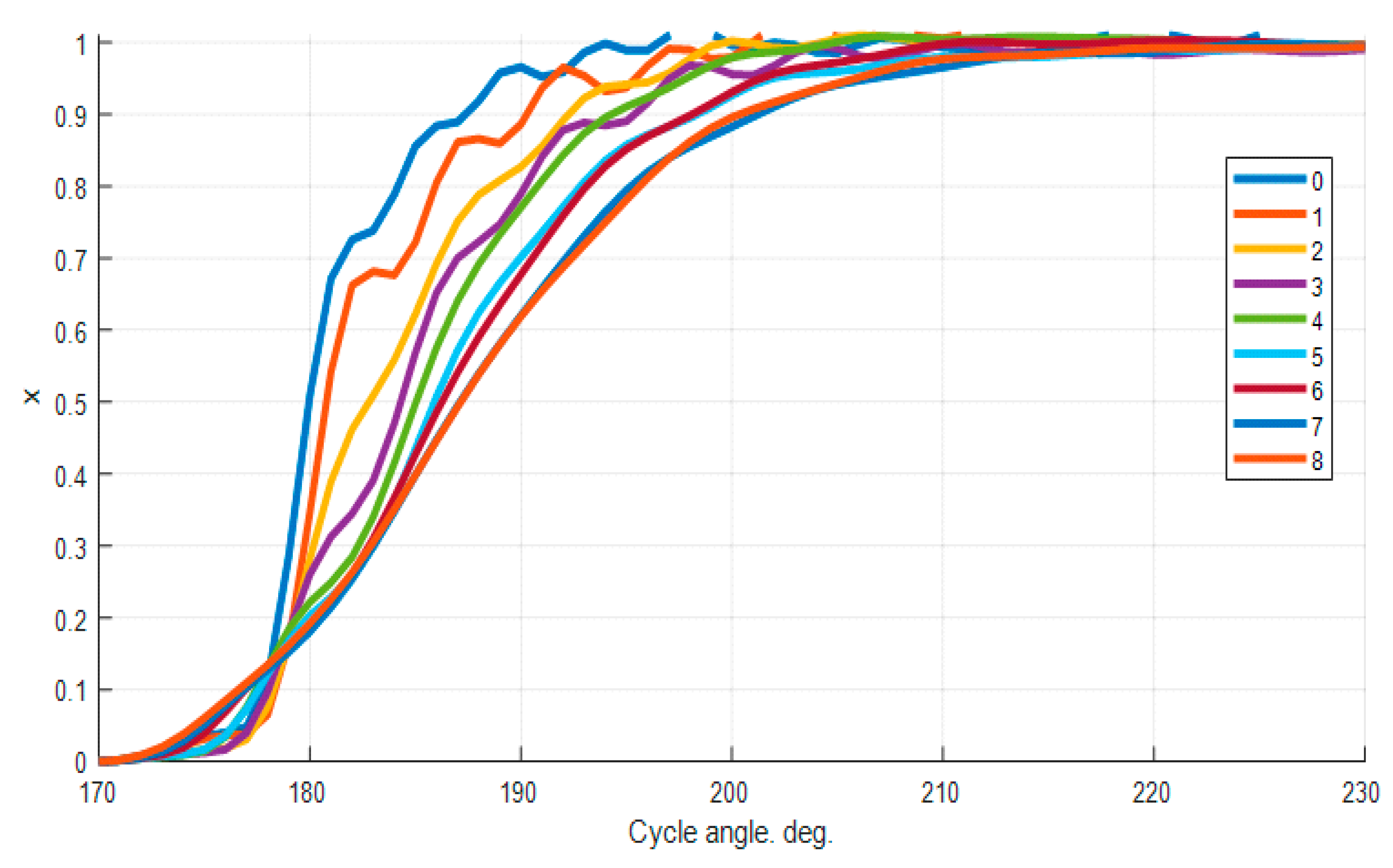
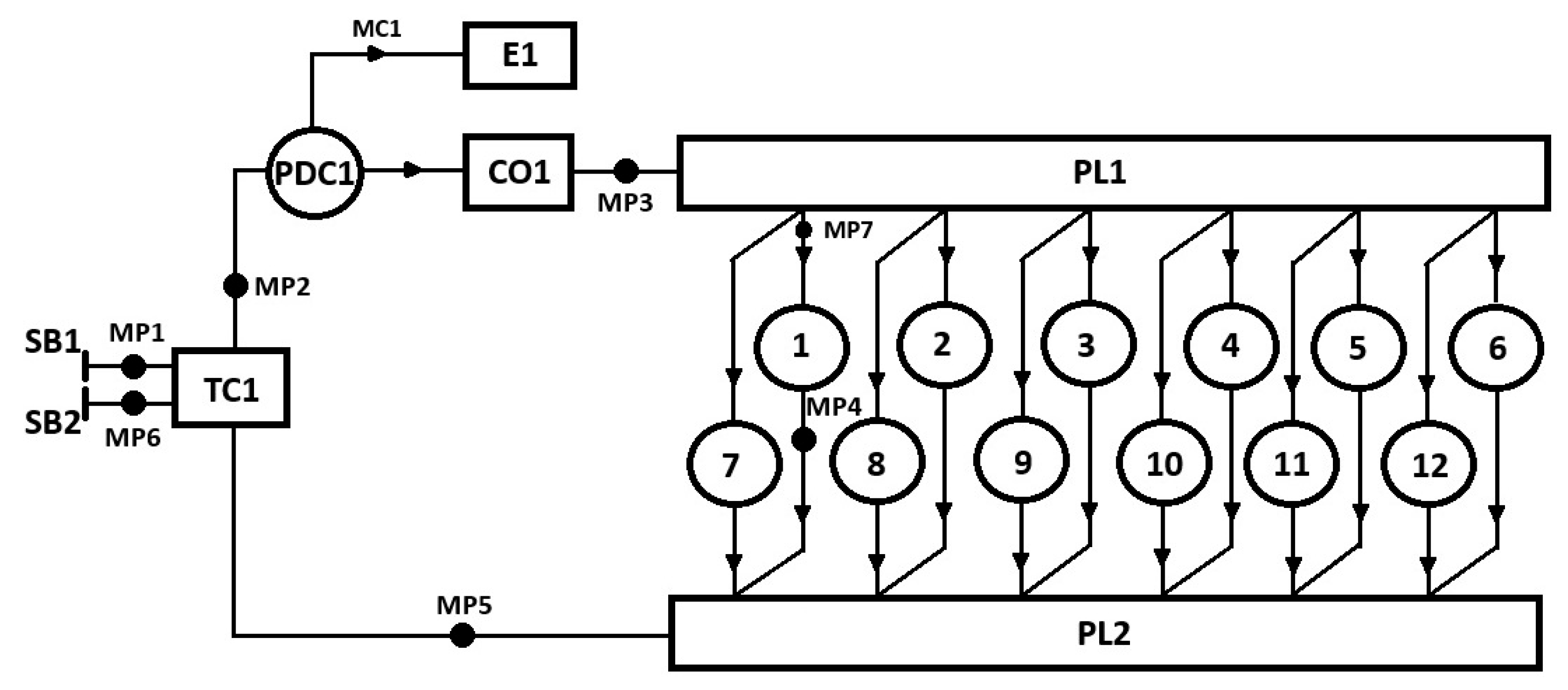
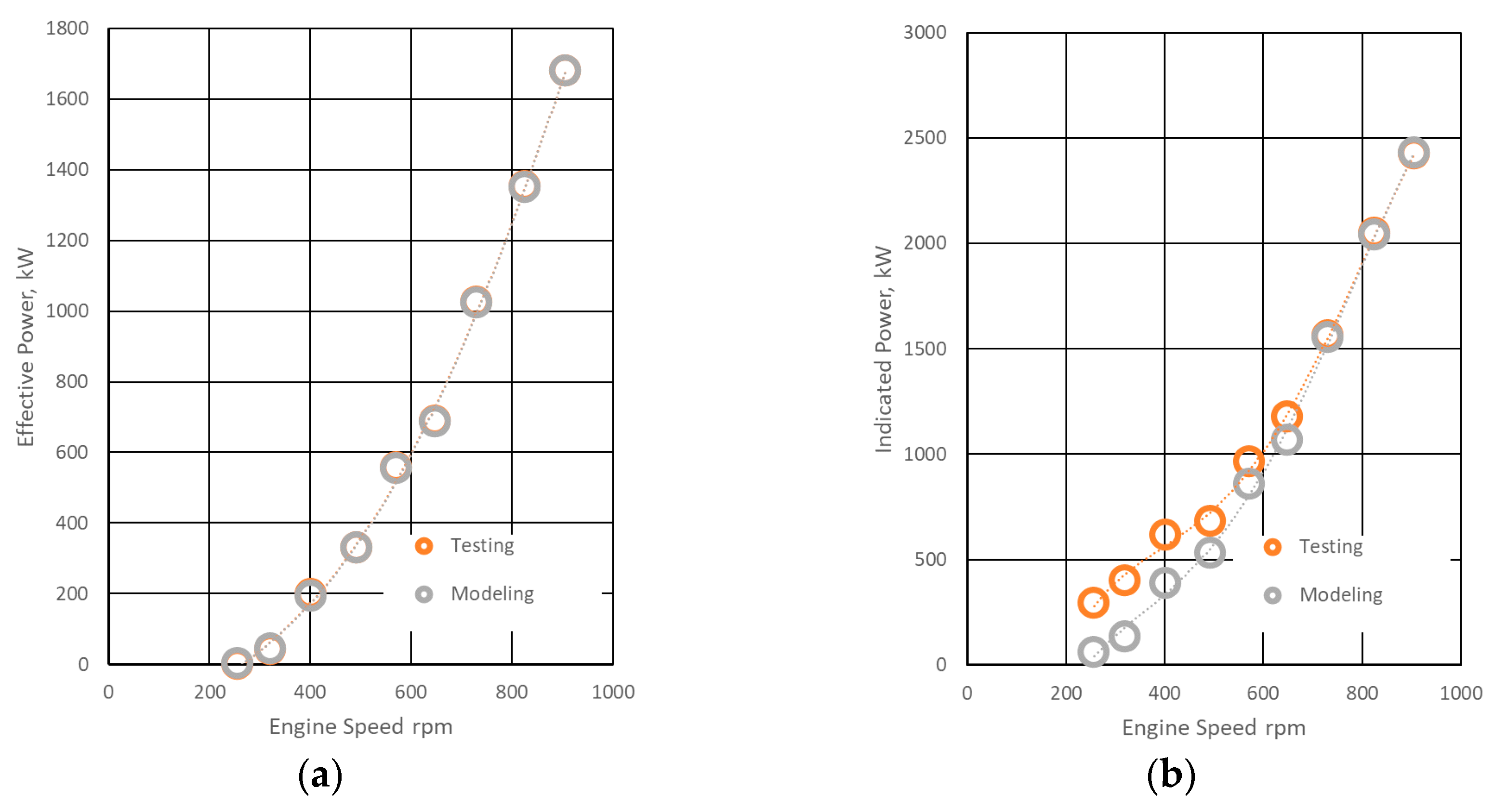
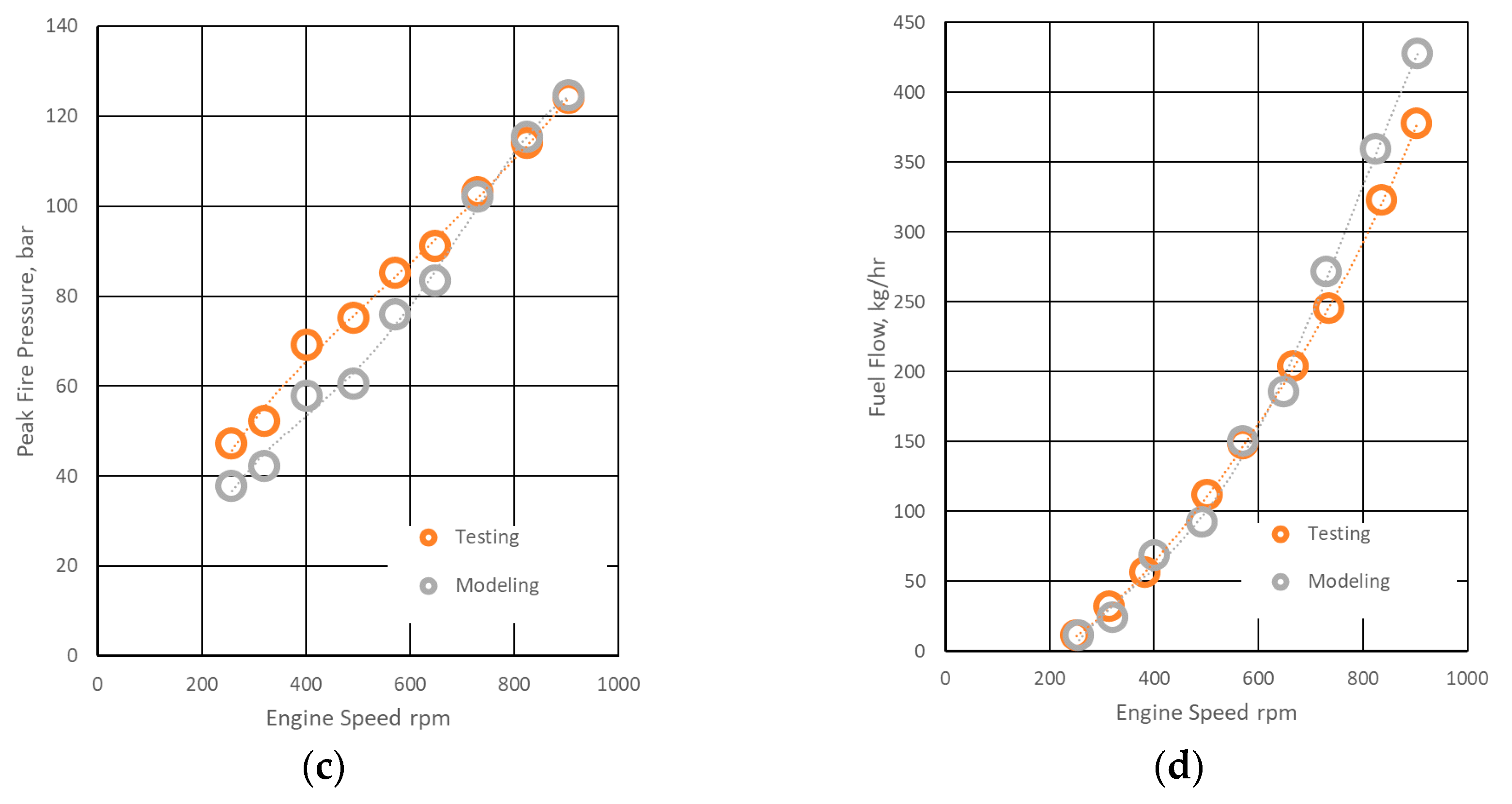
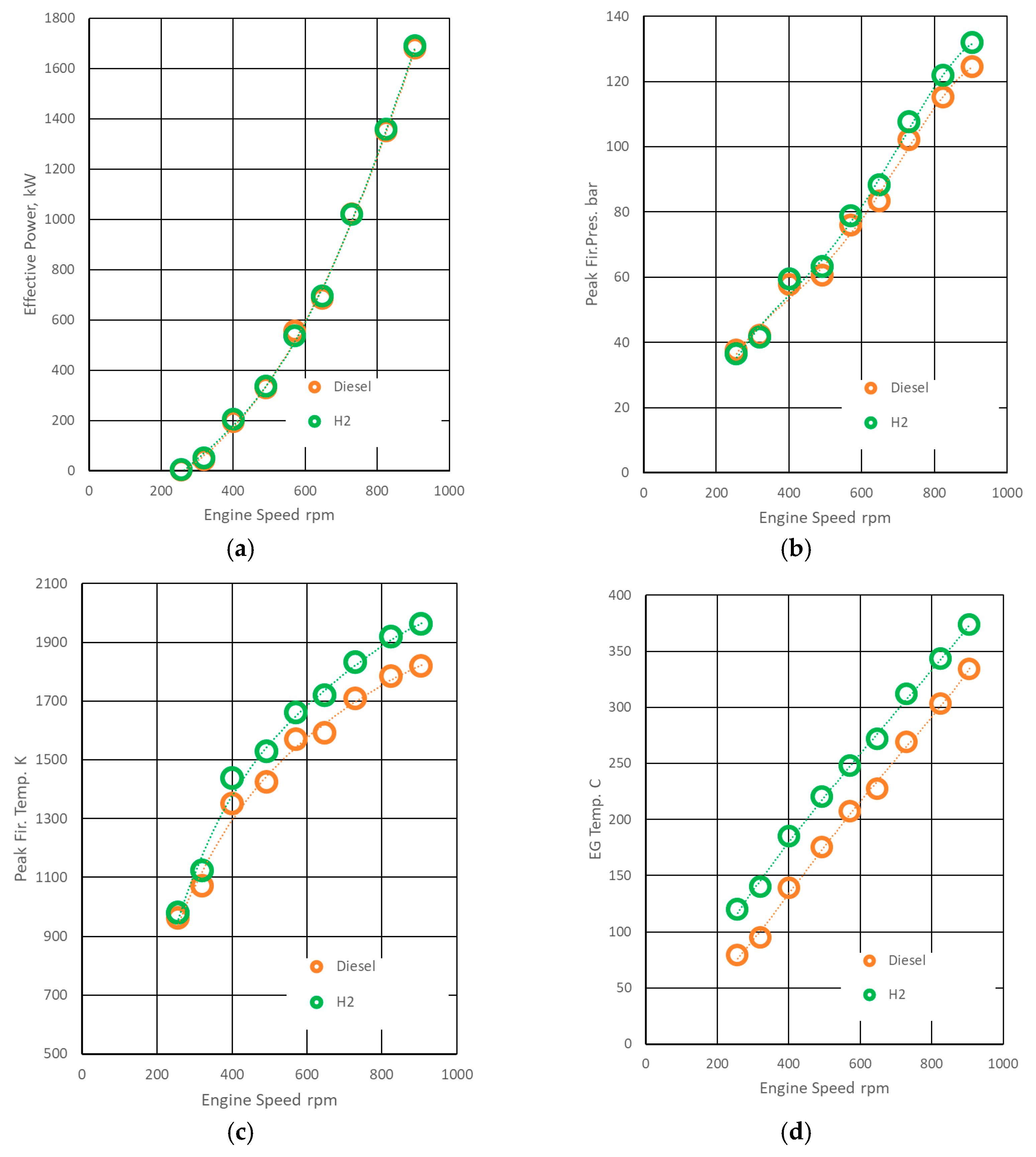
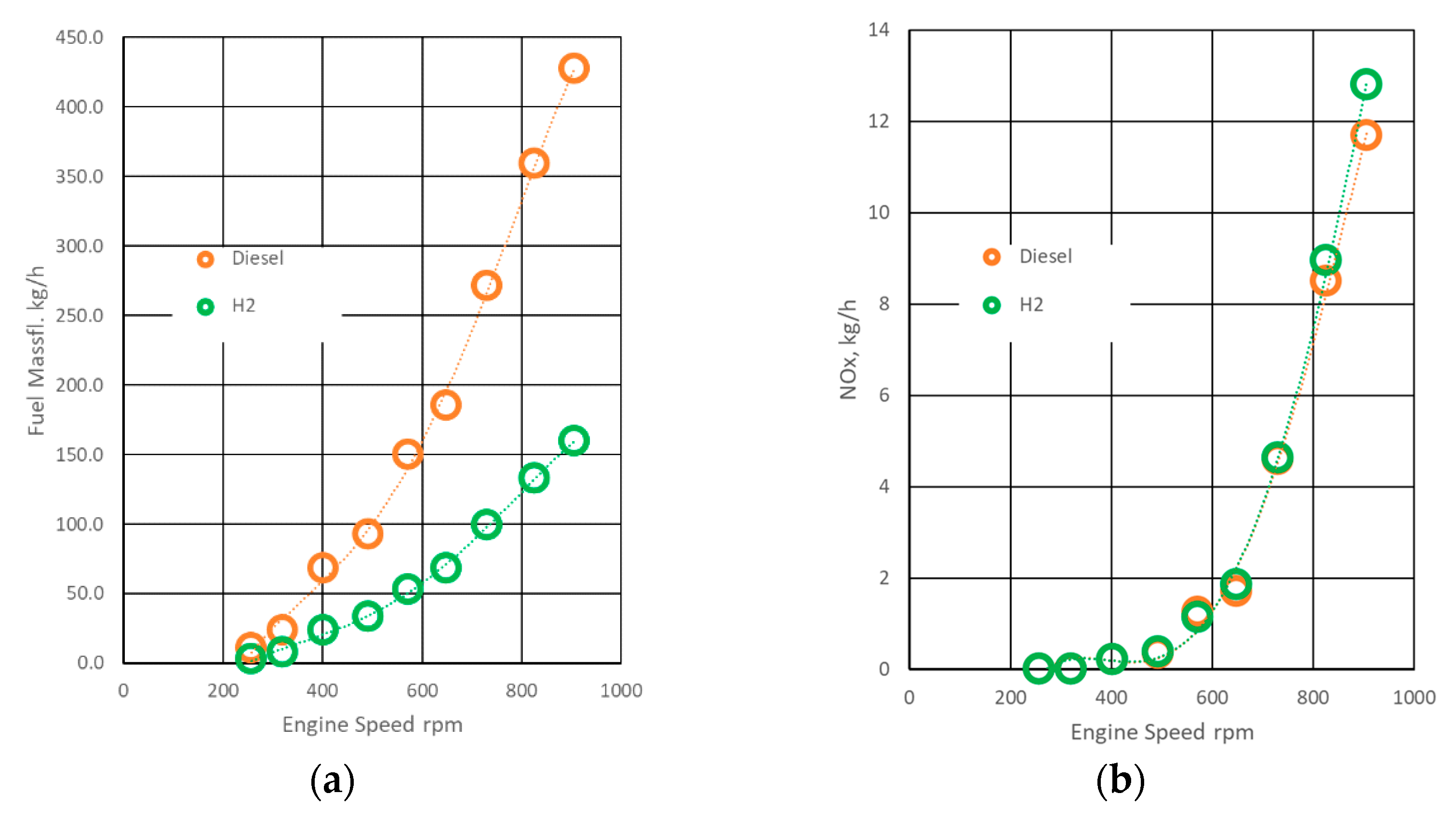
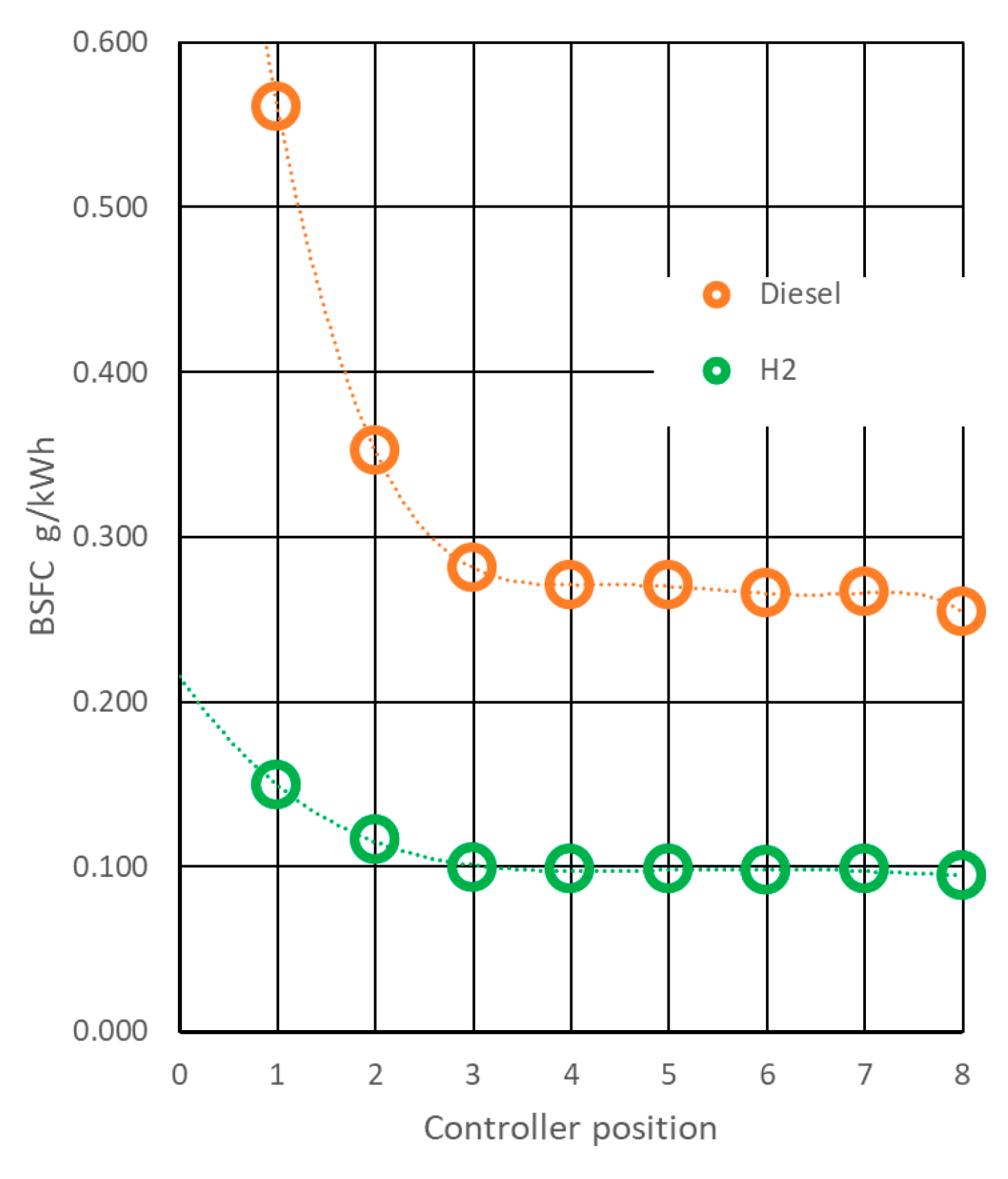
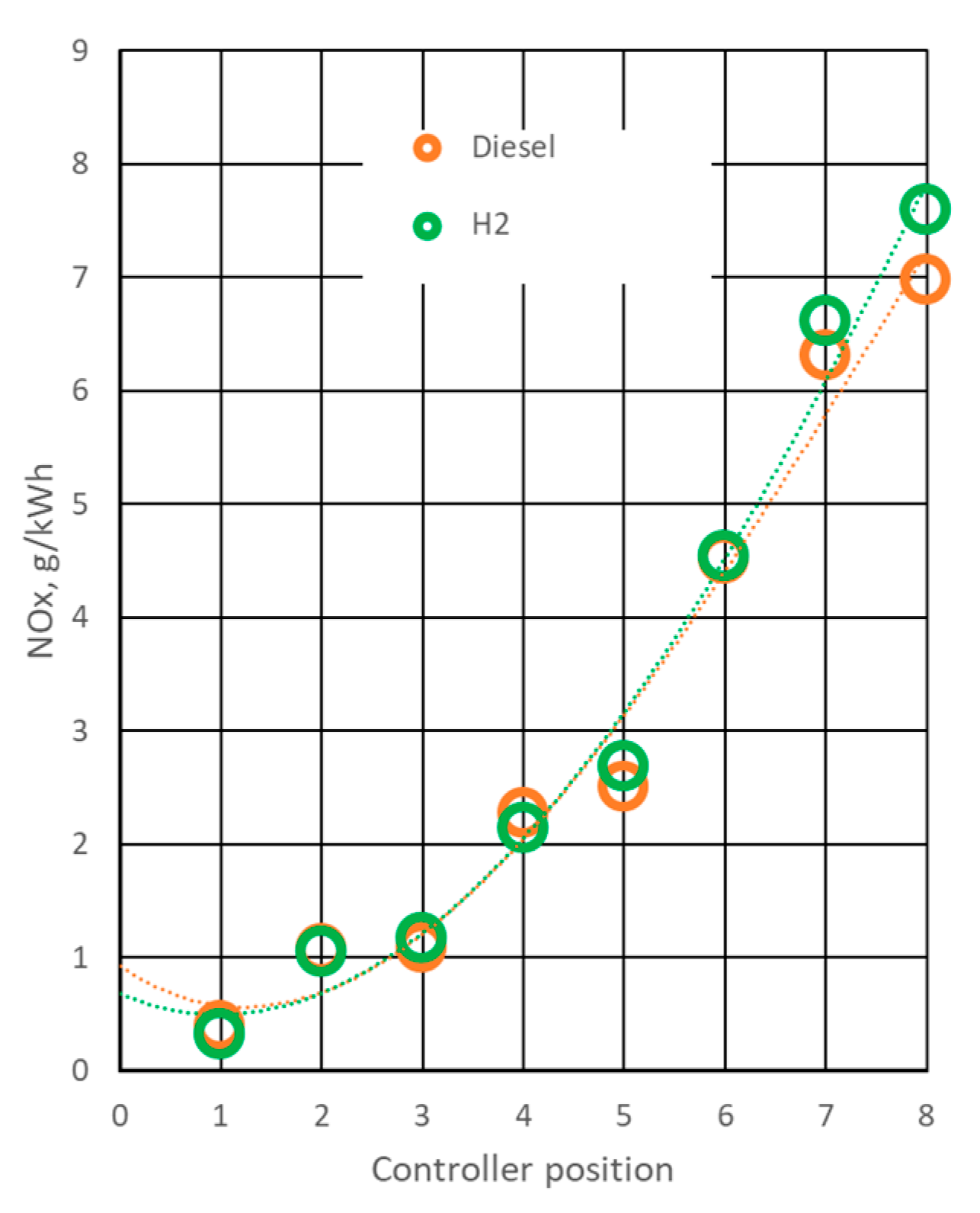
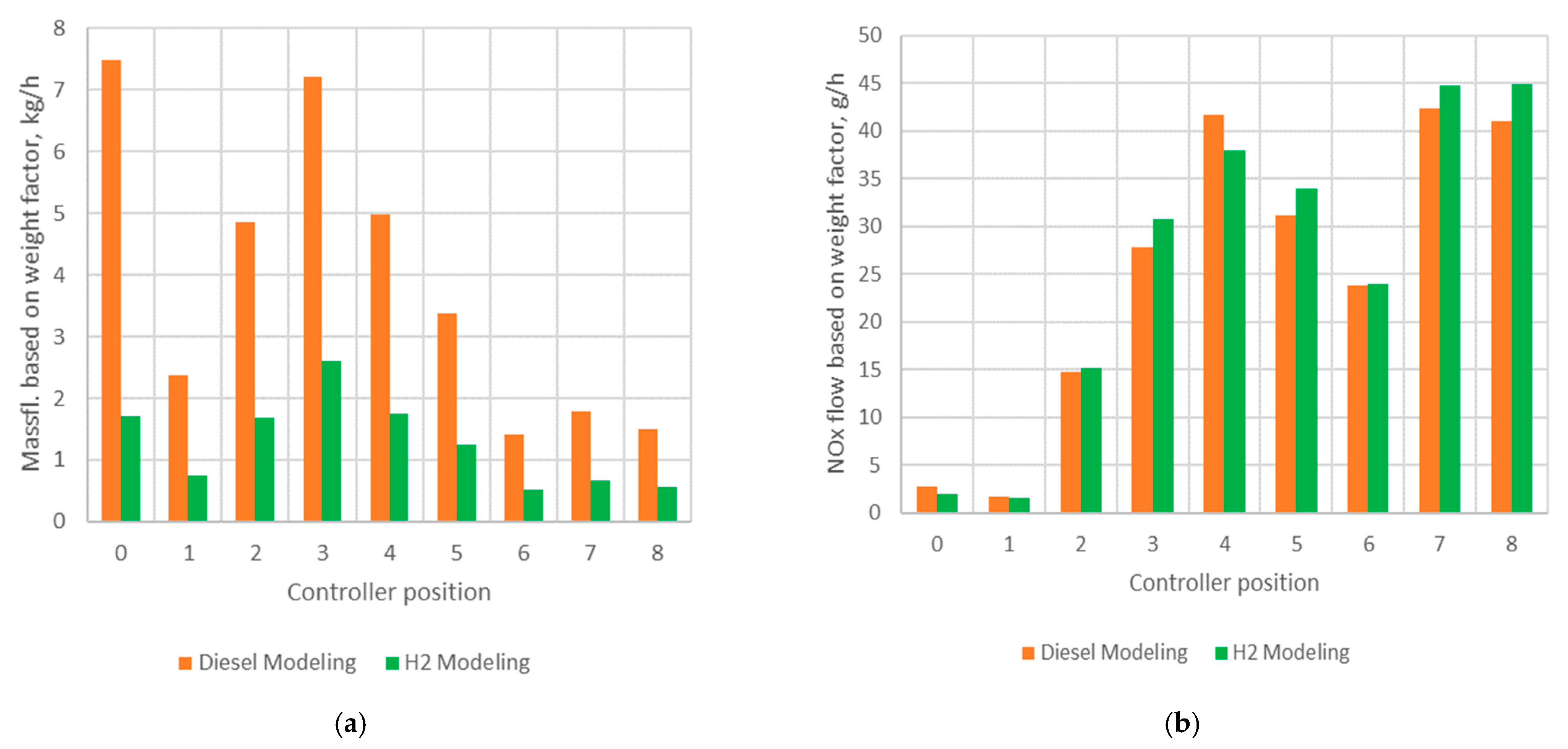
| Parameter | Meaning |
|---|---|
| Engine type | Two-stroke, V-type diesel engine |
| Number of cylinders | 12 |
| Cylinder displacement | 10.57 L |
| Total working volume | 126.84 L |
| Cylinder diameter | 230.2 mm |
| Piston stroke | 254 mm |
| Maximum power | 2510 hp (1870 kW) |
| Rated speed | 900 rpm |
| Average effective pressure | 0.16–0.94 MPa |
| Maximum cylinder pressure | Up to 12.4 MPa |
| Type of fuel system | Supercharged turbocharger |
| Fuel consumption (diesel) | 195–220 g/kWh |
| Cooling | Liquid |
| Engine weight | About 16,800 kg |
| Engine Design Parameters | |
|---|---|
| Cylinder diameter | D = 0.23019 m |
| Stroke | S = 0.254 m |
| Kinematic parameter of the crank mechanism | λ = 0.2167 |
| Compression ratio | ε = 14.5 |
| Cylinder displacement | Vh = 10.57 L |
| Number of cylinders | z = 12 |
| Chemical parameters of the fuel | |
| Stoichiometric ratio | Lo = 14.5 |
| Lower calorific value of fuel | Qn = 42,300 kJ/kg |
| Controller Position | Effective Power | Engine Speed | Intake Pressure | Intake Temperature | Peak Fir. Pres. | Peak Fir. Pres. Angle | IMEP | Peak Pressure Rise | SOC Angle | EOC Angle |
|---|---|---|---|---|---|---|---|---|---|---|
| kW | RPM | MPa | C deg. | MPa | deg. | MPa | MPa/deg. | deg. | deg. | |
| Idle | 0 | 257 | 0.15 | 38 | 4.7 ± 0 | 3 ± 1 | 0.11 ± 0 | 0.4 ± 0.1 | 177 | 189 ± 2 |
| 1 | 40 | 321 | 0.16 | 39 | 5.2 ± 0 | 4 ± 2 | 0.2 ± 0 | 0.42 ± 0.1 | 178 | 195 ± 5 |
| 2 | 197 | 402 | 0.16 | 42 | 6.9 ± 1 | 8 ± 0 | 0.45 ± 0.1 | 0.42 ± 0.1 | 177 | 197 ± 1 |
| 3 | 330 | 493 | 0.17 | 59 | 7.5 ± 1 | 7 ± 0 | 0.51 ± 0 | 0.57 ± 0.2 | 176 | 203 ± 8 |
| 4 | 557 | 572 | 0.18 | 61 | 8.5 ± 1 | 9 ± 1 | 0.71 ± 0.1 | 0.33 ± 0.1 | 175 | 200 ± 2 |
| 5 | 688 | 649 | 0.19 | 64 | 9.1 ± 1 | 10 ± 0 | 0.78 ± 0.1 | 0.42 ± 0.1 | 175 | 213 ± 10 |
| 6 | 1024 | 731 | 0.21 | 69 | 10.3 ± 1 | 11 ± 1 | 1.0 ± 0.1 | 0.35 ± 0.1 | 173 | 207 ± 8 |
| 7 | 1352 | 826 | 2.3 | 75 | 114 ± 2 | 11 ± 1 | 1.17 ± 0.2 | 0.39 ± 0.2 | 172 | 213 ± 9 |
| 8 | 1680 | 906 | 2.6 | 80 | 124 ± 3 | 11 ± 1 | 1.26 ± 0.6 | 0.40 ± 0.2 | 171 | 212 ± 8 |
| Controller Position | Engine Speed | Effective Power | Brake Power | Peak Fir. Pres. | Released Energy | Peak Fir. Temp. | EG Temp. | Fuel Massfl. | Boost Pressure |
|---|---|---|---|---|---|---|---|---|---|
| RPM | kW | % | MPa | kJ/cyl | K | C | kg/h | MPa | |
| 0 | 257 | 0 | 0.0 | 3.8 | 2.5 | 961 | 79 | 10.9 | 0.107 |
| 1 | 321 | 42 | 15.0 | 4.2 | 4.4 | 1069 | 94 | 23.7 | 0.114 |
| 2 | 402 | 193 | 23.9 | 5.8 | 10.1 | 1350 | 138 | 67.9 | 0.137 |
| 3 | 493 | 328 | 29.9 | 6.0 | 11.2 | 1422 | 175 | 92.2 | 0.136 |
| 4 | 572 | 554 | 31.0 | 7.6 | 15.8 | 1569 | 207 | 150.1 | 0.167 |
| 5 | 649 | 685 | 31.0 | 8.3 | 17.2 | 1591 | 227 | 185.0 | 0.185 |
| 6 | 731 | 1022 | 31.6 | 10.2 | 22.3 | 1708 | 269 | 271.5 | 0.221 |
| 7 | 826 | 1350 | 31.6 | 11.5 | 26.0 | 1783 | 303 | 359.2 | 0.248 |
| 8 | 906 | 1680 | 33.1 | 12.4 | 28.2 | 1817 | 334 | 427.3 | 0.267 |
| Controller Position | Engine Speed | Effective Power | Brake Power | Peak Fir. Pres. | Released Energy | Peak Fir. Temp. | EG Temp. | Fuel Massfl. | Boost Pressure |
|---|---|---|---|---|---|---|---|---|---|
| RPM | kW | % | MPa | kJ/cyl | K | C | kg/h | MPa | |
| 0 | 257 | 2 | 2.9 | 3.6 | 1.6 | 978 | 120 | 2.5 | 0.108 |
| 1 | 321 | 49 | 20.1 | 4.1 | 3.8 | 1121 | 140 | 7.4 | 0.114 |
| 2 | 402 | 203 | 25.8 | 5.9 | 9.8 | 1436 | 185 | 23.5 | 0.139 |
| 3 | 493 | 335 | 30.3 | 6.3 | 11.3 | 1528 | 220 | 33.2 | 0.138 |
| 4 | 572 | 535 | 30.3 | 7.9 | 15.6 | 1660 | 248 | 52.7 | 0.169 |
| 5 | 649 | 694 | 30.4 | 8.8 | 17.8 | 1718 | 272 | 68.2 | 0.188 |
| 6 | 731 | 1019 | 30.7 | 10.7 | 22.9 | 1830 | 312 | 99.3 | 0.224 |
| 7 | 826 | 1358 | 30.6 | 12.2 | 27.0 | 1918 | 343 | 132.9 | 0.250 |
| 8 | 906 | 1689 | 31.8 | 13.2 | 29.4 | 1960 | 373 | 159.5 | 0.269 |
| Controller Position | Relative Duration Controller Position (Weight Factor) | Fuel Mass Flow | Mass Flow Based on Weight Factor | ||
|---|---|---|---|---|---|
| % | kg/h | kg/h | |||
| Diesel | H2 | Diesel | H2 | ||
| 0 | 68.5 | 10.9 | 2.5 | 7.49 | 1.71 |
| 1 | 10.0 | 23.7 | 7.4 | 2.38 | 0.74 |
| 2 | 7.1 | 67.9 | 23.5 | 4.85 | 1.68 |
| 3 | 7.8 | 92.2 | 33.2 | 7.22 | 2.60 |
| 4 | 3.3 | 150.1 | 52.7 | 4.99 | 1.75 |
| 5 | 1.8 | 185.0 | 68.2 | 3.38 | 1.25 |
| 6 | 0.5 | 271.5 | 99.3 | 1.41 | 0.51 |
| 7 | 0.5 | 359.2 | 132.9 | 1.79 | 0.66 |
| 8 | 0.4 | 427.3 | 159.5 | 1.50 | 0.56 |
| Integral consumption | 35.00 | 11.46 | |||
| Controller Position | Relative Duration Controller Position (Weight Factor) | NOx Mass Flow | Mass Flow Based on Weight Factor | ||
|---|---|---|---|---|---|
| % | g/h | g/h | |||
| Diesel | H2 | Diesel | H2 | ||
| 0 | 68.5 | 4 | 3 | 3 | 2 |
| 1 | 10.0 | 16 | 16 | 2 | 2 |
| 2 | 7.1 | 207 | 212 | 15 | 15 |
| 3 | 7.8 | 355 | 392 | 28 | 31 |
| 4 | 3.3 | 1256 | 1143 | 42 | 38 |
| 5 | 1.8 | 1708 | 1860 | 31 | 34 |
| 6 | 0.5 | 4598 | 4624 | 24 | 24 |
| 7 | 0.5 | 8497 | 8959 | 42 | 45 |
| 8 | 0.4 | 11,689 | 12,809 | 41 | 45 |
| Integral consumption | 227 | 235 | |||
Disclaimer/Publisher’s Note: The statements, opinions and data contained in all publications are solely those of the individual author(s) and contributor(s) and not of MDPI and/or the editor(s). MDPI and/or the editor(s) disclaim responsibility for any injury to people or property resulting from any ideas, methods, instructions or products referred to in the content. |
© 2025 by the authors. Licensee MDPI, Basel, Switzerland. This article is an open access article distributed under the terms and conditions of the Creative Commons Attribution (CC BY) license (https://creativecommons.org/licenses/by/4.0/).
Share and Cite
Dumenko, P.; Prokhorenko, A.; Smigins, R. Simulation of the Hydrogen Railway Engine Performance Under Different Load Conditions and Control Parameters. Energies 2025, 18, 5694. https://doi.org/10.3390/en18215694
Dumenko P, Prokhorenko A, Smigins R. Simulation of the Hydrogen Railway Engine Performance Under Different Load Conditions and Control Parameters. Energies. 2025; 18(21):5694. https://doi.org/10.3390/en18215694
Chicago/Turabian StyleDumenko, Petro, Andriy Prokhorenko, and Ruslans Smigins. 2025. "Simulation of the Hydrogen Railway Engine Performance Under Different Load Conditions and Control Parameters" Energies 18, no. 21: 5694. https://doi.org/10.3390/en18215694
APA StyleDumenko, P., Prokhorenko, A., & Smigins, R. (2025). Simulation of the Hydrogen Railway Engine Performance Under Different Load Conditions and Control Parameters. Energies, 18(21), 5694. https://doi.org/10.3390/en18215694







